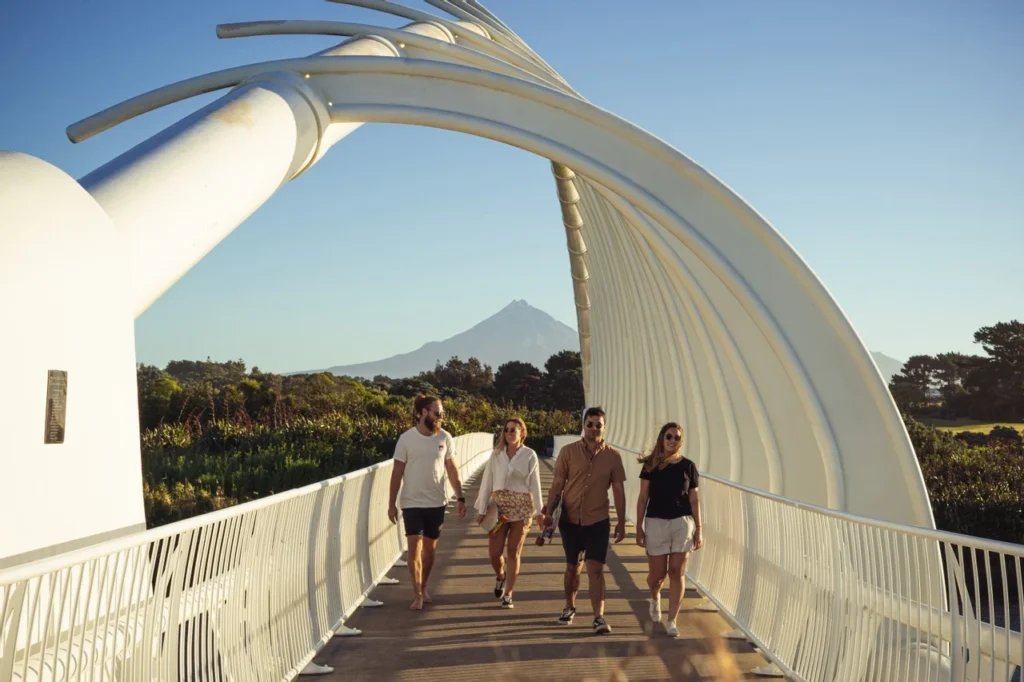Taranaki is a uniquely positioned region with untapped potential. Well-known for its incredible lifestyle, visitors and residents alike enjoy the stunning warm beaches in summer and the snowy mountain in winter. Every aspect of nature is right at your fingertips, and that’s before you explore the local eateries, walks and lifestyle activities on offer. The figures back up the region’s popularity as well and support why it was in the top 5 for investor hotspots in 2021.
Over the past 11 years the population of the region has increased by 1% each year, now standing at around 124,380 people. Taranaki’s GDP only decreased by 0.5% in 2021, faring much better than the NZ average of 1.2%. And while much of the region’s economy previously hinged upon the oil and gas sectors, government investment sees it transition to a low-emissions economy as part of its vision to 2050.
This all makes Taranaki a very attractive place for renters to settle into and is one of the main drivers behind its growing population. It’s not only the population that seems to be growing but also the local businesses seeking to support this growing population. There’s a variety of boutique coffee shops and restaurants, galleries, and iconic festivals that make Taranaki quite the destination – there truly is something for everyone to enjoy.
In this article, we’re going to explore the reasons why Taranaki is a great place for property investors to investigate. From the low increases in median house prices compared to other regions to the high rental incomes, we’ll look objectively at the region’s trajectory. As experts in the local property market, we’ll look at population growth, regional investment, the promising signs of continued growth to uncover the reasons why Taranaki is perfect for your next property investment.
If you’re concerned about buying a property outside of the region you live in then don’t worry. As Taranaki’s longest-running property management company, and with 8 offices covering the entire region we’re your experts on the ground. You can rely on us to find, manage, and maintain your investment property, as well as place the perfect tenants.
Without further delay let’s explore why Taranaki is the perfect region for the property investor looking to grow their portfolio.
1. Low median house prices
One of the core reasons Taranaki is such an appealing region for property investment is its low increase in median house prices compared to other New Zealand regions. For example, the median price for residential properties in New Zealand increased from $780,00 in January 2021 to $885,000 in February 2022. In contrast, the median price for a house in Taranaki is only sitting at the $665,000 mark as of February 2022. This is 28.85% lower than New Zealand’s median house price.
In comparison, regions such as Northland and the Bay of Plenty saw significant annual increases in median house prices. Northland increased by 29.6% (from $625,000 to $810,000) and the Bay of Plenty increased by 22.8% (from $767,000 to $942,000). Of course, Taranaki is still recording a median house price increase, but it is smaller compared to other New Zealand regions. For example, from January 2021 to January 2022, Taranaki increased by 21.2% (from $520,000 to $630,000). In the current market, just about every region across New Zealand is noticing significant increases in median house prices. In comparison, Taranaki’s annual increase seems a little less daunting which certainly draws the attention of property investors.
For the property investor looking for new acquisitions, this means your property dollar can go further in Taranaki.
2. High rental yield
Taranaki consists of 3 main hubs and a few smaller towns all surrounding the mountain and hugging the beautiful coastline. This range of towns cover various price points and, therefore, investment opportunities – there’s something for everyone! Each also commands different rental prices and demand, depending on the local economies.
The main centres include New Plymouth, Hāwera, and Stratford and the neighbouring towns to these include Inglewood, Waitara, Ōpunake, and Ōakura. We’ll take a close look at each of Taranaki’s beautiful townships and their average weekly rental income below to give you an idea of what’s available.
Hāwera
Hāwera is the largest town in South Taranaki. It’s a bustling and growing town that sits on the main route between New Plymouth and Wellington. The Fonterra processing facility is in close proximity which supports the economy with a range of jobs.
Hāwera has a great median home value that currently sits at $469,000 with 26.08% annual growth. The median weekly rent is sitting at $425.
Stratford
Also in South Taranaki, Stratford is the largest town in the Stratford district! It is quite the rural community with some of New Zealand’s best farming centred on this township, and plenty of history too. There’s an array of things to do in Stratford from sports to recreational activities with a large golf course, stunning walks, parks, and more.
Stratford’s median home value is currently $499,000 with a 35.23% annual growth rate. The median weekly rent is $410.
Inglewood
Inglewood is a short 10-minute drive from New Plymouth and nestled between Stratford and New Plymouth, meaning you can head to Stratford and climb Mount Taranaki to play in the snow, then head to one of New Plymouth’s many popular beaches for a surf, all on the same day! Inglewood’s property market has been growing in popularity over the years, especially amongst New Plymouth first home buyers looking to get onto the property ladder!
Inglewood has a median home value of $575,000 with a 21.05% annual growth rate. The median weekly rent is $470.
Waitara
Waitara is a residential township located roughly 16km northeast of central New Plymouth. It sits along the coastline with various parks, large rivers and reserves, making it a desirable family location. Also, being so close to New Plymouth gives this town even more of a family appeal, and therefore, a slightly higher rental income potential.
Waitara has a median home value of $457,000 with 25.21% annual growth. The median weekly rent is $400.
Ōpunake
Ōpunake is where things slow down – in a good way. It’s a very relaxed coastal town offering a desirable lifestyle. It hosts one of the West Coast’s most popular beaches and is a stunning spot for families and retirees to wind down.
Ōpunake has a median home value of $449,000 at a rate of 21.68% annual growth. The median weekly rent is currently $400.
Ōakura
Ōakura is another of Taranaki’s beautiful coastal suburbs, this one offering a luxury lifestyle to go with the shimmering black sand. It’s also in close proximity to central New Plymouth, sitting just 15km south, about a half-hour drive. There’s a wide range of both luxury and affordable homes surrounded by breathtaking views, epic surf, and gorgeous cafes and eateries.
The desirable lifestyle and upper-end homes in Ōakura are reflected in its higher median house price of $970,000. But this flows through into the median weekly rent, which is currently $600.
New Plymouth
New Plymouth is the main population hub of Taranaki and is enriched with culture and heritage. There’s a lot to do with a great assortment of shops, restaurants, cafes, and recreational activities. New Plymouth hosts stunning botanical gardens, beaches, and various hidden tracks. It is one of the most desirable places to live and work in Taranaki.
The median house price in New Plymouth is $632,000 with the median weekly rent sitting at $450.
3. There’s a high demand for rental properties
With such a broad range of townships, houses, and rental properties, the demand across Taranaki for both affordable and luxury rental properties stands high. In turn, when rental properties are presented to the market, they are often snatched up quickly. Unfortunately, Taranaki is no exception from the low property supply and high demand. However, this makes for wise property opportunities.
The larger cities offer excellent rental incomes, and while the smaller towns may not capture such premium returns they do offer many great potential tenants who are ready to find their next home. Taranaki is not included in the new medium density housing laws, which means increased housing supply is unlikely to be available in the short or medium-term. This means prospective homeowners are likely to look to rental properties for the foreseeable future.
At present 29.31% of the population of Taranaki lives in rentals and this could be behind the drive behind Aucklanders looking at New Plymouth in more detail.
4. There’s a wide range of property types available
Taranaki’s wide range of suburbs is home to an array of property types. There are options ranging from rural to residential and commercial. Looking even more closely among these categories, there are farmhouses with large sections, apartments, beach-side villas, and so much more. There’s a range of sizes from studio apartments to 6+ bedroom family homes. However, you’ll more commonly find houses within the 2-4 bedroom range. There’s also an assortment of classic homes as well as recently built and more luxury-feeling properties. There’s a property to suit every investment preference and requirement. Feel free to browse our current listings to gain a sense of the breadth of investment opportunities available throughout the Taranaki region.
5. Taranaki is a growing region
Taranaki’s stunning surroundings are certainly beginning to draw in the crowds. The 2018 census had Taranaki’s population sitting at 117,661 people with 45,555 occupied private dwellings. This means Taranaki makes up approximately 2.5% of New Zealand’s total population with New Plymouth being home to nearly 70% of the region’s population. Before the COVID-19 pandemic hit, Taranaki’s population was forecast to grow 11.3% by 2043. Most of the region’s population increase has come from net migration, indicating that population growth will continue. Due to its desirable location, surroundings, and all the region has going on, Taranaki is becoming an increasingly popular destination.
6. Regional investment in Taranaki
Taranaki has the second-highest productivity in the whole of New Zealand, contributing 2.9% of its GDP! The region’s incredible economic performance stems from dairy farming and processing, as well as oil and gas industries. There’s a lot of regional investment happening across Taranaki. Government investment includes over $13m to spur tourism and also in realising its clean energy goals and hydrogen fuel opportunities. The region’s infrastructure is also seeing investment. The Mt Messenger bypass improves road safety for traffic heading north from the region and the famous Forgotten World Highway is seeing a major upgrade too. There’s a lot of growth happening throughout the region which has increased regional investment and truly makes Taranaki a place to keep your eyes on.
7. Taranaki shows promising signs of continued growth
The region’s ambitious 50-year regional growth plan is the driving force behind this change and pushes the region towards a future built on sustainability. It sets out the plan for short-term actions and medium-term strategy required to achieve Taranaki’s long-term vision for growth and prosperity in 2050. Not only is the population continuing to grow, but the region itself is also evolving to accommodate for this and create a top tier place to live for New Zealanders now and in the future.
Ultimately, there are countless reasons why Taranaki is a great place to invest in, and these are just our top 7! From the low increases in median house prices compared to other regions to the high rental incomes, population growth, regional investment, and promising signs of continued growth, there are a number of reasons why Taranaki is perfect for your next property investment.
And while it can be daunting to invest out of your primary region the rewards can be even greater as a result. Feel free to contact our team of experienced property managers who are more than happy to share their expertise on the area you’re thinking of investing in.
With decades of experience managing properties across Taranaki, your new out-of-region investment couldn’t be in safer hands.







